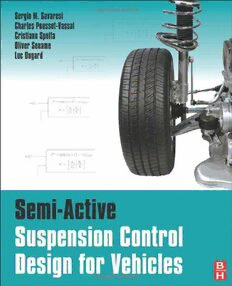
Semi-Active Suspension Control Design for Vehicles PDF
232 Pages·2010·9.071 MB·English
Most books are stored in the elastic cloud where traffic is expensive. For this reason, we have a limit on daily download.
Preview Semi-Active Suspension Control Design for Vehicles
Description:
Design greener, safer, and more cost-efficient vehicles using semi-active suspension systems Semi-active suspension systems promise weight efficiencies, cost savings, and higher safety and comfort compared to other types of electronically-controlled suspensions currently in use. With the growing emphasis on fuel economy, reduced CO2 emissions, and cost reductions for all vehicles, these semi-active systems are set to become a growing part of overall vehicle design, but coverage of them in standard automotive engineering texts is currently limited. Semi-Active Suspension Control Design for Vehicles provides a comprehensive overview of semi-active suspension systems with an emphasis on performance analysis and control design. Several different approaches using different control theories are presented and evaluated in the book, with methodology provided to analyze and evaluate suspension performances while identifying optimal performance bounds. Further features and coverage include: Explanations of two innovative semi-active suspension strategies to enhance either comfort or road-holding performance, with complete analyses of both A case study showing complete implementation of all the presented strategies Summary descriptions of classical control algorithms for controlled dampers Intended as an application-oriented reference for automotive engineers, a tutorial resource for students in automotive systems and a control design-oriented text for researchers, Semi-Active Suspension Control Design for Vehicles presents an authoritative account of this critical vehicle dynamics topic based on the extensive academic and industrial research of this expert author team. Appropriate as a tutorial for students in automotive systems, an application-oriented reference for engineers, and a control design-oriented text for researchers that introduces semi-active suspension theory and practiceIncludes explanations of two innovative semi-active suspension strategies to enhance either comfort or road-holding performance, with complete analyses of bothAlso features a case study showing complete implementation of all the presented strategies and summary descriptions of classical control algorithms for controlled dampers
See more
The list of books you might like
Most books are stored in the elastic cloud where traffic is expensive. For this reason, we have a limit on daily download.
